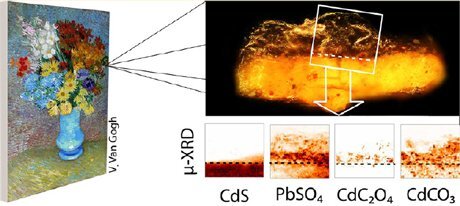Cadmium yellow (CdS) is a modern pigment that was intensively used by Ensor, Van Gogh and their progressive contemporaries (Monet, Seurat, Picasso, etc.) because of its bright yellow colour. In spite of its excellent reputation regarding permanency, fading of the yellow colour and loss of adhesion of the CdS paint layers has been reported by several authors. Analysis of paint samples by means of a combination of various synchrotron radiation-based techniques (µ-XRF/µ-XANES/µ-XRD/µ-FTIR) allowed unravelling for the first time, the complex chemical transformations that take place at the (sub)micro-level. The latter are responsible for changes in the morphology and colour of the paint layer and cause a substantial change in the appearance of the affected paintings. For that reason, the degradation of cadmium yellow was studied on two paintings: ‘Still life with coffeepot, cabbages and mask’ by James Ensor and ‘Flowers in a blue vase’ by Vincent Van Gogh.

In both the Ensor as the Van Gogh case a primary oxidation process had taken place, converting the sulphide ions (S2-) into sulphate ions (S6+). It appears that upon the photo-induced oxidation of its sulphidic counter ion, the Cd2+ ions reprecipitated after formation of a complex with oxalate-ions, while the sulphates migrated and found a suitable reaction partner in Pb2+ ions in the varnish, possibly supplied by dissolved lead-based driers.
The different secondary reaction pathway on the Van Gogh painting, caused by the application of a varnish, explained the divergent degradation morphology observed in both cases. For the Ensor case the transformation of the bright yellow CdS into the colourless CdSO4.H2O answered for the observed fading of the yellow colour, while for the Van Gogh case, the formation of a cadmium oxalate film at the paint/varnish interface combined with the crystallisation of anglesite in the varnish layer accounted for the reported disturbing, opaque grey crust. These new insights have direct and practical consequences in the field of conservation-restoration.